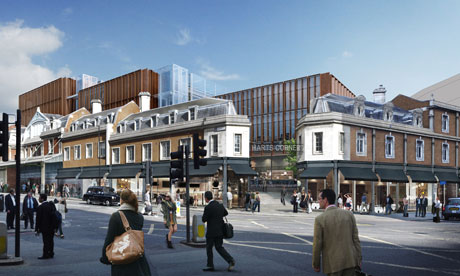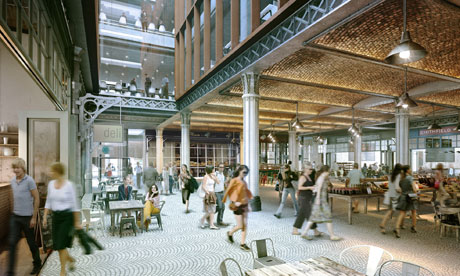Smithfield plans will 'destroy grandest parade of market buildings in Europe'
Save Britain's Heritage speaks out against the latest plans for London's historic Smithfield market

'It's a scoop-out' ... plans will see facade retained, with office buildings behind
As the Victorian Society publishes its list of the top 10 most endangered Victorian and Edwardian buildings, it might be sobering to look at a scheme that will destroy, according to Save Britain's Heritage, "the grandest parade of market buildings in Europe".
The latest plans for London's Smithfield General Market, unveiled this week by Henderson Global Investors, follow a long and chequered history of brutal attempts to flatten the historic complex.
Built between 1866 and 1883 by Horace Jones, architect of the other City markets and Tower Bridge, the ornate halls formalised an activity that had been carried out on the site for over a thousand years. The famousMeat Market is still functioning and is safe for the time being, but the collection of buildings to the west have lain derelict for some time.
The General Market, Fish Market, and what's known as the Red House make up about a quarter of the whole complex, and it is these that have been threatened with demolition and replacement by big floorplate commercial blocks – actively encouraged by the City's thirst for yet more office space, despite the current glut.
A muscular glass and steel megalith by KPF was thankfully thrown out in 2008 by the then communities secretary, Hazel Blears, after a four-year battle. Developer Thornfield then appointed John McAslan, whose practice has a strong track record of sensitive interventions in historic environments, but again plans were scuppered when the client went into administration.
The site was subsequently acquired by Henderson, which has retained McAslan and come back with a proposal that will apparently "preserve the historic identity of the market buildings through the retention, restoration and reuse of the most significant parts of the historic buildings".
Their scheme includes a two-part piazza within the General Market building, arranged to provide "much needed vibrant and visually attractive activity" to the neighbouring streets. The developer also trumpets the "sensitive inclusion" of new "low-rise pavilions" of office space – which in fact rise to a height of 20m.
The use of the term "pavilions" for substantial buildings has become a common planning application trope, used by Richard Rogers' One Hyde Park development, where vast residential towers attempt to dissemble their bulk behind this ludicrous moniker. It makes little more sense here, where three boxy blocks will tower above the huddled roofline of the market below.
"It's another scoop-out job," says Clem Cecil of Save Britain's Heritage, referring to the common strategy of retaining the facade of an existing building and mining out everything behind. A similar scoop-out was recently granted for Spitalfields' Fruit and Wool Exchange, passed by Boris Johnson against the advice of the local authority and conservation groups.
At Smithfield, not only is it scooping out, it is also knee-capping the existing buildings: the entire ground floor will be replaced with glass, front and back, leaving the first floor floating in a strange parody: "a token nod towards conservation", says Cecil.
 Ground-floor view of the proposal which 'plays fast and loose with the building's historic elements and fittings'Images of the proposal suggest a more sensitive approach than what has come before, but Save argues these "beguiling" scenes "play fast and loose with the building's historic elements and fittings".
Ground-floor view of the proposal which 'plays fast and loose with the building's historic elements and fittings'Images of the proposal suggest a more sensitive approach than what has come before, but Save argues these "beguiling" scenes "play fast and loose with the building's historic elements and fittings".
"It's all very pretty, but it's just throwing sparkly dust in our eyes," says Cecil. "Look closely and it's just hashed-together conservation detailing."
Save is currently working up an alternative proposal with Burrell Foley Fischer architects which, they claim, demonstrates a financially viable alternative to demolition, utilising the warren of tunnels and storerooms beneath the market for new retail space.
With a dreary abundance of vacant office buildings already marching down Farringdon Road, the logic of adding yet more must be questioned – even with the arrival of Crossrail at Farringdon. Smithfield is a unique part of the city, one of those curious corners of old London that could surely be colonised with stalls and street life in the same way thatBorough Market or Covent Garden have been. While McAslan's scheme is an improvement on previous proposals, it does not go far enough: it will leave only a flimsy skin of heritage, a picturesque skirt of Victoriana around the base of yet another slab of generic commercial development.
The latest plans for London's Smithfield General Market, unveiled this week by Henderson Global Investors, follow a long and chequered history of brutal attempts to flatten the historic complex.
Built between 1866 and 1883 by Horace Jones, architect of the other City markets and Tower Bridge, the ornate halls formalised an activity that had been carried out on the site for over a thousand years. The famousMeat Market is still functioning and is safe for the time being, but the collection of buildings to the west have lain derelict for some time.
The General Market, Fish Market, and what's known as the Red House make up about a quarter of the whole complex, and it is these that have been threatened with demolition and replacement by big floorplate commercial blocks – actively encouraged by the City's thirst for yet more office space, despite the current glut.
A muscular glass and steel megalith by KPF was thankfully thrown out in 2008 by the then communities secretary, Hazel Blears, after a four-year battle. Developer Thornfield then appointed John McAslan, whose practice has a strong track record of sensitive interventions in historic environments, but again plans were scuppered when the client went into administration.
The site was subsequently acquired by Henderson, which has retained McAslan and come back with a proposal that will apparently "preserve the historic identity of the market buildings through the retention, restoration and reuse of the most significant parts of the historic buildings".
Their scheme includes a two-part piazza within the General Market building, arranged to provide "much needed vibrant and visually attractive activity" to the neighbouring streets. The developer also trumpets the "sensitive inclusion" of new "low-rise pavilions" of office space – which in fact rise to a height of 20m.
The use of the term "pavilions" for substantial buildings has become a common planning application trope, used by Richard Rogers' One Hyde Park development, where vast residential towers attempt to dissemble their bulk behind this ludicrous moniker. It makes little more sense here, where three boxy blocks will tower above the huddled roofline of the market below.
"It's another scoop-out job," says Clem Cecil of Save Britain's Heritage, referring to the common strategy of retaining the facade of an existing building and mining out everything behind. A similar scoop-out was recently granted for Spitalfields' Fruit and Wool Exchange, passed by Boris Johnson against the advice of the local authority and conservation groups.
At Smithfield, not only is it scooping out, it is also knee-capping the existing buildings: the entire ground floor will be replaced with glass, front and back, leaving the first floor floating in a strange parody: "a token nod towards conservation", says Cecil.
 Ground-floor view of the proposal which 'plays fast and loose with the building's historic elements and fittings'Images of the proposal suggest a more sensitive approach than what has come before, but Save argues these "beguiling" scenes "play fast and loose with the building's historic elements and fittings".
Ground-floor view of the proposal which 'plays fast and loose with the building's historic elements and fittings'Images of the proposal suggest a more sensitive approach than what has come before, but Save argues these "beguiling" scenes "play fast and loose with the building's historic elements and fittings"."It's all very pretty, but it's just throwing sparkly dust in our eyes," says Cecil. "Look closely and it's just hashed-together conservation detailing."
Save is currently working up an alternative proposal with Burrell Foley Fischer architects which, they claim, demonstrates a financially viable alternative to demolition, utilising the warren of tunnels and storerooms beneath the market for new retail space.
With a dreary abundance of vacant office buildings already marching down Farringdon Road, the logic of adding yet more must be questioned – even with the arrival of Crossrail at Farringdon. Smithfield is a unique part of the city, one of those curious corners of old London that could surely be colonised with stalls and street life in the same way thatBorough Market or Covent Garden have been. While McAslan's scheme is an improvement on previous proposals, it does not go far enough: it will leave only a flimsy skin of heritage, a picturesque skirt of Victoriana around the base of yet another slab of generic commercial development.
No comments:
Post a Comment